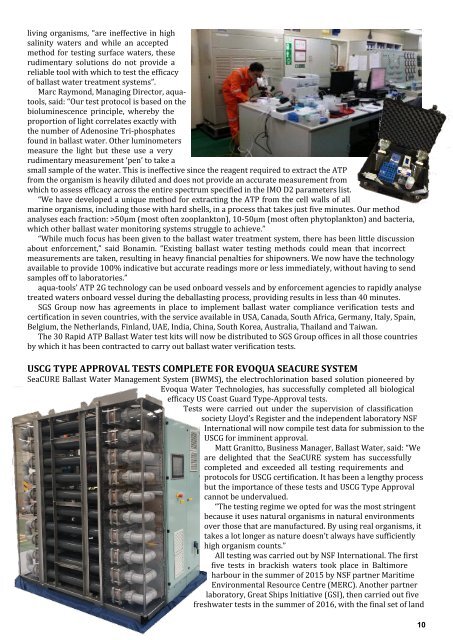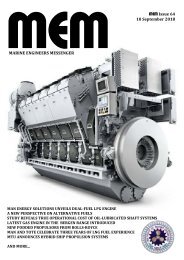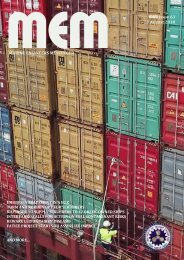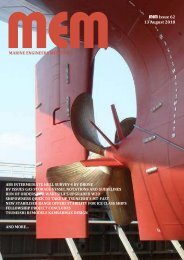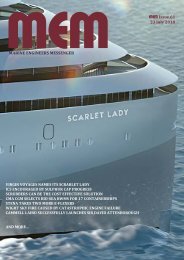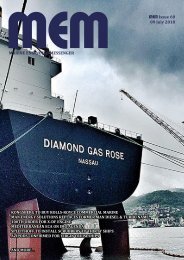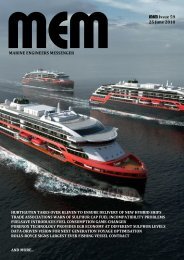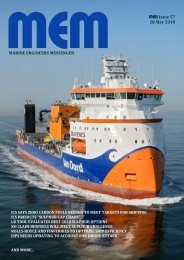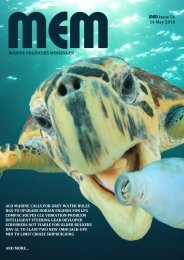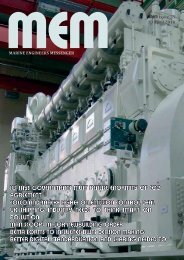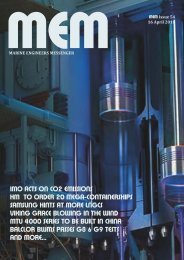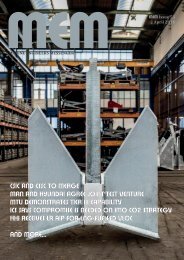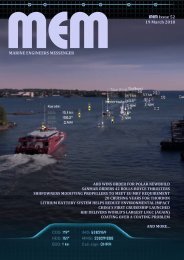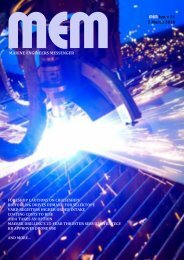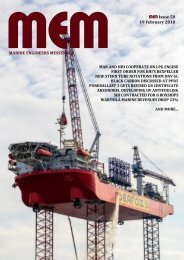MEM38
Marine Engineers Messenger Volume 2 Issue 38
Marine Engineers Messenger Volume 2 Issue 38
Create successful ePaper yourself
Turn your PDF publications into a flip-book with our unique Google optimized e-Paper software.
living organisms, “are ineffective in high<br />
salinity waters and while an accepted<br />
method for testing surface waters, these<br />
rudimentary solutions do not provide a<br />
reliable tool with which to test the efficacy<br />
of ballast water treatment systems”.<br />
Marc Raymond, Managing Director, aquatools,<br />
said: “Our test protocol is based on the<br />
bioluminescence principle, whereby the<br />
proportion of light correlates exactly with<br />
the number of Adenosine Tri-phosphates<br />
found in ballast water. Other luminometers<br />
measure the light but these use a very<br />
rudimentary measurement ‘pen’ to take a<br />
small sample of the water. This is ineffective since the reagent required to extract the ATP<br />
from the organism is heavily diluted and does not provide an accurate measurement from<br />
which to assess efficacy across the entire spectrum specified in the IMO D2 parameters list.<br />
“We have developed a unique method for extracting the ATP from the cell walls of all<br />
marine organisms, including those with hard shells, in a process that takes just five minutes. Our method<br />
analyses each fraction: >50μm (most often zooplankton), 10-50μm (most often phytoplankton) and bacteria,<br />
which other ballast water monitoring systems struggle to achieve.”<br />
“While much focus has been given to the ballast water treatment system, there has been little discussion<br />
about enforcement,” said Bonamin. “Existing ballast water testing methods could mean that incorrect<br />
measurements are taken, resulting in heavy financial penalties for shipowners. We now have the technology<br />
available to provide 100% indicative but accurate readings more or less immediately, without having to send<br />
samples off to laboratories.”<br />
aqua-tools’ ATP 2G technology can be used onboard vessels and by enforcement agencies to rapidly analyse<br />
treated waters onboard vessel during the deballasting process, providing results in less than 40 minutes.<br />
SGS Group now has agreements in place to implement ballast water compliance verification tests and<br />
certification in seven countries, with the service available in USA, Canada, South Africa, Germany, Italy, Spain,<br />
Belgium, the Netherlands, Finland, UAE, India, China, South Korea, Australia, Thailand and Taiwan.<br />
The 30 Rapid ATP Ballast Water test kits will now be distributed to SGS Group offices in all those countries<br />
by which it has been contracted to carry out ballast water verification tests.<br />
USCG TYPE APPROVAL TESTS COMPLETE FOR EVOQUA SEACURE SYSTEM<br />
SeaCURE Ballast Water Management System (BWMS), the electrochlorination based solution pioneered by<br />
Evoqua Water Technologies, has successfully completed all biological<br />
efficacy US Coast Guard Type-Approval tests.<br />
Tests were carried out under the supervision of classification<br />
society Lloyd’s Register and the independent laboratory NSF<br />
International will now compile test data for submission to the<br />
USCG for imminent approval.<br />
Matt Granitto, Business Manager, Ballast Water, said: “We<br />
are delighted that the SeaCURE system has successfully<br />
completed and exceeded all testing requirements and<br />
protocols for USCG certification. It has been a lengthy process<br />
but the importance of these tests and USCG Type Approval<br />
cannot be undervalued.<br />
“The testing regime we opted for was the most stringent<br />
because it uses natural organisms in natural environments<br />
over those that are manufactured. By using real organisms, it<br />
takes a lot longer as nature doesn’t always have sufficiently<br />
high organism counts.”<br />
All testing was carried out by NSF International. The first<br />
five tests in brackish waters took place in Baltimore<br />
harbour in the summer of 2015 by NSF partner Maritime<br />
Environmental Resource Centre (MERC). Another partner<br />
laboratory, Great Ships Initiative (GSI), then carried out five<br />
freshwater tests in the summer of 2016, with the final set of land<br />
10


